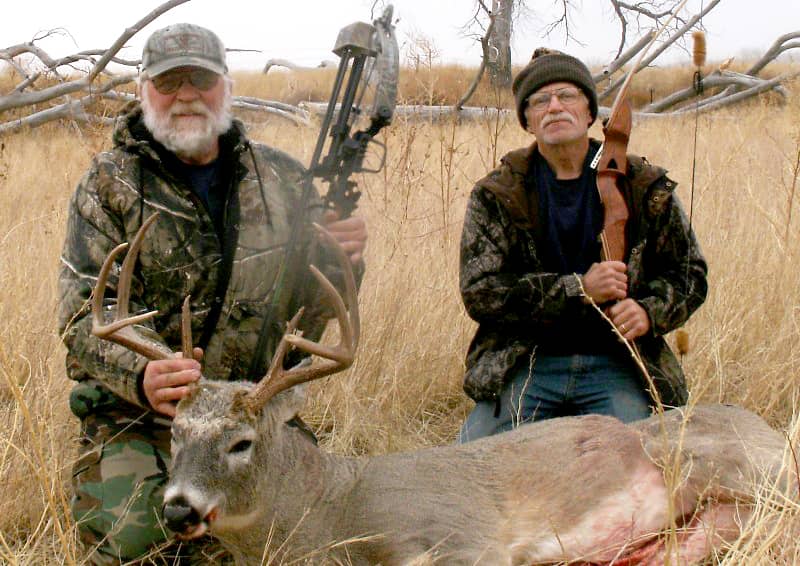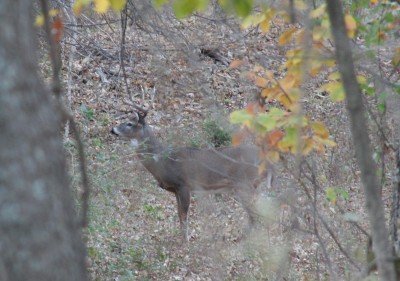A New Twist on an Old Theme: Teamwork Rattling
Bernie Barringer 10.29.13

Think you’ve read everything there is to know about rattling for bucks? Here’s something that will significantly increase your odds of bringing them in and getting a shot.
Rattling has been responsible for the demise of many whitetails in areas where competition for breeding creates a fertile environment for buck fights. Where bucks fight, rattling works. But mature bucks show some tendencies that make it difficult to get them close enough for a shot—and to be sure, the older bucks have heard it all before and they don’t come trotting in with their tongues hanging out.
Many bucks have been rattled into shooting range by a hunter in a treestand or hidden on the ground, but having a buddy do the rattling while the hunter is at the ready increases the odds of getting off a shot. A scientific study done on the results of rattling reveals some insights into rattling success that add an interesting twist to this tactic.
Scientists in Texas conducted a study on the results of rattling, carefully recording the responses of bucks relating to the weather conditions including wind speed and direction, cloud cover, and temperature. They also noted time of day and conducted the rattling sequences, both long and short, with loud rattling and soft rattling.
There’s one more important aspect of the study that offers significant insight you can use to bag a buck this year. An observer was placed in a 30-foot-tall observation tower downwind of the person doing the rattling. The results were quite revealing. Over the course of the study, they rattled 171 times and recorded the results. The observer in the tower saw 111 bucks during those 171 rattling sequences and the person doing the rattling only saw 48! There were two primary reasons the tower observer saw more than twice as many bucks: 1) visibility was better, and 2) the bucks tended to circle downwind of the source of the rattling sound. In fact, 83 percent bucks circled downwind of the sound of the rattling.

Rattling works everywhere buck-to-doe ratios are in balance. Chances are you can see more bucks where you hunt if you are in a treestand downwind of the source of the rattling sound. Teaming up with a partner will significantly increase your odds of getting a shot. Have a buddy move 40 to 50 yards upwind of your stand and rattle from the ground. You are in position to capitalize on a buck which has his attention—vision, hearing, and smelling—focused away from your position.
The study results
In the rattling study, researchers used four combinations of volume and length of rattling, Short and Quiet (SQ); Long and Quiet (LQ); Short and Loud (SL); and Long and Loud (LL). The quiet sequences were done with the elbows held tight to the sides so the antlers could not be clashed together with much force. The loud sequences including scraping trees and pounding the antlers on the ground.
The SL and LL sequences were performed 85 times and attracted 81 bucks; while the SQ and LQ were performed 86 times and attracted only 30 bucks; roughly a third as many as the louder sequences.
Even with the loud rattling, they had bucks run right up to the sound of the rattling. Clearly, clashing the antlers together in loud and raucous fashion is better than quiet rattling. The scientists commented that the bucks seemed to respond more quickly and aggressively to the noisy sequences.
Rattling alone can be effective, but the results of this study and the personal experiences of many people, particularly guides and outfitters who do a lot of rattling, illustrate how much more effective it can be to rattle in a partnership. While the buck is focused on the source of the sound, the hunter has a better chance to ready for the shot without being busted.
There is no question that rattling loud is the way to go. Rattle hard and rattle often. On the ground or in a tree, two hunters really are better than one. Take turns rattling with a buddy and see if your sightings, and corresponding buck shootings, increase.
Follow Bernie’s bowhunting adventures on his blog, bowhuntingroad.com.

